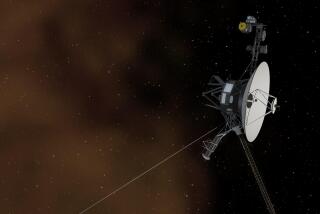Before Messenger crashes on Mercury, NASA bids spacecraft farewell
- Share via
NASA’s Messenger spacecraft is about to end its mission with a bang. After spending more than four years and 4,100 orbits circling the closest planet to the sun, the satellite will crash into Mercury’s crater-pocked surface April 30.
NASA officials and mission scientists have given tribute to the Messenger spacecraft, which was the first to orbit Mercury and which they say has fundamentally altered our understanding of this scorched little world.
“We study Mercury because it’s part of our history. It’s part of who we are and where we come from,” science team member Thomas Zurbuchen of the University of Michigan in Ann Arbor said in a statement. “We’re at the end of a really successful mission, and we can’t do anything anymore to stop it from doing what it naturally wants to do. The sun is pulling on it. The planet is pulling on it. It’s just physics. It has to crash.”
Launched in August 2004, the spacecraft has revealed many unexpected insights about that “first rock from the sun”: that, even within scorching distance, it has reserves of polar ice holding frozen water; that organic matter also coats protected areas near the poles; and that the tiny planet has a strong but lopsided magnetic field.
“The spacecraft and the instruments have worked virtually flawlessly over those four years,” James Green, director of NASA’s Planetary Science Division in Washington, said in a briefing Thursday.
Mercury is among the least-studied planets in our solar system. Messenger was the first mission since the Mariner 10’s final flyby in 1975 to study this little planet up close.
With so little previously known about Mercury, Messenger has opened up a trove of new information – and several surprises – in its three flybys and four years of orbiting the planet, said Sean Solomon, the mission’s principal investigator and director of Columbia University’s Lamont-Doherty Earth Observatory in New York.
Solomon put together a top-10 list of greatest discoveries made possible by Messenger. Among them: that the planet has an exceedingly thin atmosphere that changes with the seasons – and that sometimes trails behind the planet in a comet-like tail; that Mercury has shrunk by nearly 9 miles in diameter; and that volcanism played a major role in shaping the planet’s surface. There are even different types of volcanic material on the surface that probably came from different reservoirs in the planet, he added.
“We have a record, if only we could read it – and we’re working on that now,” Solomon said at the Thursday briefing.
The most important of the discoveries, he said, tops his list: that Mercury was surprisingly high in volatile elements, including potassium, sulfur, sodium and chlorine. Scientists had not expected this planet to be so high in these elements, which are thought to be among the first to escape a planet, particularly when it’s so close to the sun.
“It allows us to reject most of the ideas for how Mercury was assembled as a planet at the beginning of the history of the solar system,” Solomon said.
The most interesting, he said, was probably the second on his list – that the spacecraft was able to confirm the presence of polar water ice in permanently shadowed regions at the bottoms of craters.
“Those polar regions, I think, are calling out to people like Jim Green and saying, ‘Send us another spacecraft, we have more stories to tell,’” Solomon said, eliciting laughter from Green and others.
Green said that as a magnetosphere physicist, he was fascinated by Mercury’s lopsided magnetic field.
“I really enjoyed the magnetic field topologies. ... How does that really happen inside a planet?” Green said.
However, Messenger has only so much fuel, mission engineers pointed out.
“At the end of this month … we will lose our battle with solar gravity,” Messenger’s project manager, Helene Winters of the Johns Hopkins University Applied Physics Laboratory in Maryland, said at the briefing. It will crash into the surface at about 8,700 mph, she added.
Messenger will send back data until minutes before its crash, said mission systems engineer Daniel O’Shaughnessy, also of the Johns Hopkins lab.
Data already sent back by the spacecraft will continue to be analyzed in the years to come, Solomon said.
Even in death, Messenger will prove useful. On impact, the spacecraft will make a roughly 52-foot-wide crater, a planetary scar whose characteristics may be useful for study by future spacecraft. More are coming: The joint European-Japanese mission BepiColombo is set to arrive at Mercury in 2024.
Follow @aminawrite for more science news.







